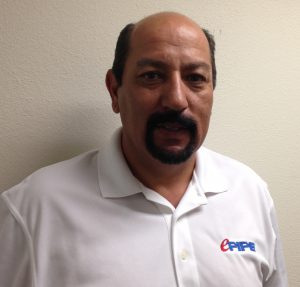One on One with Ray Munguia
By Gina Dostler
Re-piping when a leak has caused water damage to a home or commercial property requires time and expensive reconstruction. Fifteen years ago, Pipe Restoration Inc. started using a new method lining pipes that Ray Munguia, vice president of operations, says costs less and is less disruptive.
Q: How does ePIPE work?
A: Pipes corrode through a number of factors that work alone or in combination that cause pinhole leaks, discolored water, low water flow, lead and copper containments. We coat the insides of the pipes with a NSF 61 certified epoxy to keep the pipes from corroding. It’s almost like putting a new pipe in an old one. It is minimally invasive, requiring very little reconstruction afterwards.
Q: What is the process?
A: We locate the pipes that come out of the wall, such as underneath the sink, and place adaptors that connect us with the entire water system. The first step involves drying the pipes with air. Then we sand the inside with an aluminum oxide that cleans and profiles the piping so the epoxy adheres to the sides. Finally we inject the epoxy into the system. A 2 ½ bedroom home would take around 8 – 10 hours to complete. The epoxy cures in two hours and the water can be turned back on that very day. For commercial buildings, depending on the problem, we can usually turn it around over the weekend with very little disruption in the business operations.
Q: Does the coating narrow the piping and disrupt pressure?
A: The coating is very thin. It’s like placing two sheets of paper together. In most cases, we achieve a 10 ml finish, but have approval for 4 ml to 120 ml because some applications require a lighter or heavier coating depending on the diameter of the pipes in the system. We also do a pre-flow and post-flow check to make sure the water flow is compliant to the plumbing code.
Q: What about the chemicals in the epoxy? Are there any type such as BPA that leak into the water?
A: There are no chemical leaks from our epoxy once it’s cured and it also meets all of the criteria from the International Association of Plumbing and Mechanical Officials. The product was tested in Finland where tests and their approval process are much more stringent than we have here in the United States. Questions about BPA did arise in the beginning and after testing they measured no BPAs in the water after the resin was cured. What we use is a two-part epoxy that is NSF 61 and ANSI approved. NSF approves all materials and components that are used in the installation of potable water systems to help protect health effects of the consumer.
Q: Is it environmentally friendly?
A: Yes. It minimizes the leaching of harmful metals such as lead into drinking water that not only occurs from some pipes, but the 50/50 sodder that is used to connect pipes together. And since it restores the existing pipe without cutting into cement, walls, floors or ceilings that happens with most re-piping, there is reduced waste and strain on landfills.
Q: What types of pipes can be restored?
A: Both metallic and non-metallic pipes including copper, lead, steel, black iron, PVC, CPVC, and Pex can be restored with the ePIPE. The types of piping include domestic water, radiant heating, snowmelt, fire sprinkler, natural gas piping, industrial process piping, and pool piping systems. There are different types of epoxy for the different applications.
Q: Are there any situations you could not use ePIPE?
A: It’s rare, but I’ve had occasions where the piping was neglected for so long the pipe walls were thin as paper. In those cases we are not able to restore the system with ePIPE and would instead have to do re-piping. But when someone has already done the process, it’s not uncommon for us to do multiple homes for that person such as rentals or vacation homes for piece of mind to avoid any corrosion that can cause many problems in the future.
Q: Is it an expensive application and how long does it last?
A: The cost is comparable to re-piping. But the savings occurs in all the avoided reconstruction costs when using ePIPE versus replacing pipes that require breaking and tearing up of the property. We’ve been doing it for 15 years and never had an issue of the product failing or not lasting. There was accelerated testing done in a laboratory with results showing the product lifespan to be 50 – 75 years.
CONTACT INFORMATION
Ray Munguia
Pipe Restoration Inc.
3122 West Alpine Street
Santa Ana, CA 92704
714-564-7600
www.RestoreMyPipes.com



